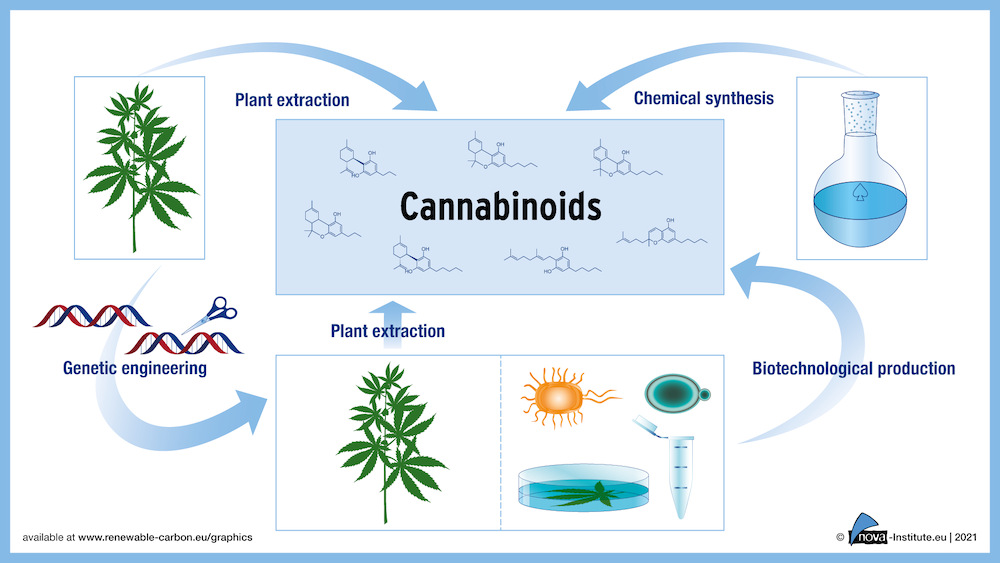The new report “Production of Cannabinoids via Extraction, Chemical Synthesis and Especially Biotechnology – Current Technologies, Potential & Drawbacks and Future Development” provides all information on production technologies, medical applications and political framework conditions (www.renewable-carbon.eu/publications). The Report will guide you through the complex synthesis of cannabinoids, state-of-the-art methods for extraction and production and will extensively show the major hidden potential and synergistic effects of biotechnological cannabinoid production.
Visuals and PDF files in German and English available at: www.nova-institute.eu/press/?id=233.
The report is aimed at experts in the pharmaceutical and biotech industry and provides deep insights into (bio)chemical reactions, processes and producers. The main authors are biotechnology experts and physicians from the nova-Institute, Dr. Pia Skoczinski and Dr. med. Franjo Grotenhermen, and the chemist Dr. rer. nat. Bernhard Beitzke, who has been advising the “European Industrial Hemp Association” (EIHA) as an expert for years. The 142-page technology report provides in-depth information on established and emerging biotechnological approaches on the production of cannabinoids, as well as an overview on the state-of-the-art production methods using plant extraction and chemical synthesis. An extensive description of pharmacological effects, therapeutic potential and medicinal applications for ∆9-tetrahydrocannabinol (∆9-THC) and cannabidiol (CBD), together with a short excursus on the EU regulatory framework for cannabinoids, conclude this comprehensive study. Additionally, 59 companies active in cannabinoid production are listed, from which 20 specialised in biotechnological production and chemical synthesis are described in detail.

Cannabis sativa as one of the oldest and most versatile cultivated plants has been used by humans for over 5,000 years, ranging from fibre production over seeds for food and feed, as well as oils for food and technical applications to medicinal use of cannabinoids for the treatment of pain, depression and nausea among a variety of other symptoms. After 60 years of being listed as a Schedule IV controlled substance, also referred to as the “prohibition schedule”, the UN has removed Cannabis and Cannabis resin from this list. In addition, natural CBD, first announced to might qualify as a narcotic under the UN Single Convention on Narcotic Drugs, has been declared to be not considered as such by the European Commission. These decisions will enable and drive further research to access the full medicinal potential.
Cannabinoids are one of the best-known and extensively studied classes of secondary metabolites from C. sativa. For 40 years ∆9-THC is classified as a narcotic drug and authorised by the Food and Drug Administration (FDA) as a medicinal product for medical issues and uses, such as side effects of cancer chemotherapy and loss of appetite with weight loss in HIV/AIDS patients. On the other hand, the non-psychotropic CBD is assumed to currently account for 50 % of the global hemp industry revenue, expecting this CBD market to grow globally up to USD 3.5 billion in 2024. Besides these two commonly known cannabinoids, about 120 different cannabinoids have been identified in total in C. sativa.
Targeted biotechnological synthesis of the currently known 120 different cannabinoids that are only represented in small amounts in the plant can circumvent the current limits of unveiling the pharmacological profile and effects.
Biotechnological production routes and resulting synergistic effects with current state-of-the-art extraction and production processes will enable the elucidation of possible further beneficial effects of these molecules, that are currently unknown. Biotechnological production of cannabinoids can be achieved in many different ways: In eukaryotes, such as plants, algae, eukaryotic cell cultures and yeast, but also in prokaryotes, such as bacteria, or in enzymatic cell-free systems. Natural cannabinoid synthesis in C. sativa is performed via a complex pathway system that combines enzymes, products and intermediates from three different pathways.
What is the current status of plant extraction and chemical synthesis? What requirements are needed for biotechnological cannabinoid production? What is the most promising production host? What are the advantages and disadvantages of plant extraction, chemical synthesis and biotechnological cannabinoid production? Does biotechnology have the potential to provide rare cannabinoids in significant amounts? Which synergies might emerge with these three production routes and how can they drive the future development of cannabinoid production?
The answers to these questions and the current state of biotechnological cannabinoid production, as well as plant extraction and chemical synthesis have been extensively reviewed and finally compared to show general technology-related claims and to elaborate the potential of biotechnological cannabinoid production, possible synergistic effects of all three production routes and to outline the future development of cannabinoid production.
nova technology reports and market studies are built on top of latest insights from market experts, thorough research and a large number of individual interviews with industry players to ensure highest quality of the available market data. The technology report “Production of Cannabinoids via Extraction, Chemical Synthesis and Especially Biotechnology – Current Technologies, Potential & Drawbacks and Future Development” is now available for € 2,000 – this and further market studies on various topics of renewable carbon can be found at: www.renewable-carbon.eu/publications.
Source
nova-Institut GmbH, press release, 2021-01-20.
Supplier
European Industrial Hemp Association (EIHA)
nova-Institut GmbH
Share
Renewable Carbon News – Daily Newsletter
Subscribe to our daily email newsletter – the world's leading newsletter on renewable materials and chemicals













